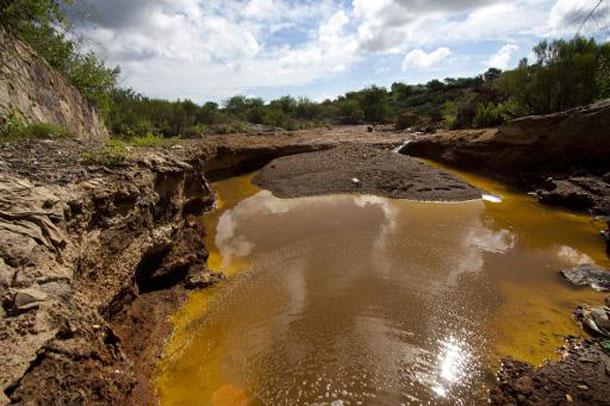A recent leak of sulfuric acid into the Mexico’s Sea of Cortez arouses anger and concern
Contaminated water near the Buenavista copper mine in Cananea, Sonora, Mexico, taken in August 2014.
On July 9, 2019, a facility operated by mining company Grupo Mexico spilled thousands of liters of sulfuric acid into the Sea of Cortez, raising environmental concerns and doubts about the Mexican government’s willingness to hold extraction companies accountable when they pollute.
The Sea of Cortez, also known as the Gulf of California, is home to a wide range of endemic marine life found nowhere else on earth, and it’s a critical stopover for rare migrating animals, including humpback whales.
About 3,000 liters of sulfuric acid spilled into the port of Guaymas, on the southwestern coast of the state of Sonora, explains Kendal Blust, a reporter for public radio station KJZZ in Phoenix, Arizona. The spill was caused by a valve failure between pipes carrying the sulfuric acid.
Residents worry about the spill’s impact on marine life, on local and commercial fishermen who depend on the Sea of Cortez’s abundance for their livelihoods, and on tourism in the area, Blust says. Locals took to the streets to express their anger and frustration with Grupo Mexico, the mining company responsible, and with the Mexican government, whom local residents say is not exercising proper oversight of the company.
Related: Nigerian widow seeks justice for husband and the Ogoni Nine
Experts who have tested the water say the spilled acid was diluted fairly quickly and the pH levels of the water returned to normal in a couple of days. More concerning to the residents, however, than the long-lasting consequences from this spill, is “a continued pattern of problems associated with Grupo Mexico,” Blust says.
In 2014, 11 million gallons of copper sulfate and heavy minerals spilled from Grupo Mexico’s Buenavista copper mine in Cananea, Sonora, into the Bacanuchi River, a tributary of the Sonora River, Blust says. Both of those waterways, which serve thousands of people in Sonora, were contaminated. About a month later, heavy rains overflowed dams on the rivers, causing agricultural areas nearby to be inundated with the contaminated water.
“It was a really confusing and scary time for a lot of residents in the communities around the Rio Sonora. … So, this spill, rather than being itself a huge disaster, is a reminder of the disasters that have happened before and that can happen again.”
“It was a really confusing and scary time for a lot of residents in the communities around the Rio Sonora,” Blust says. “So, this spill, rather than being itself a huge disaster, is a reminder of the disasters that have happened before and that can happen again.”
Related: Vancouver, WA, activist wins a Goldman Environmental Prize
The government’s response to the 2014 spill was also a cause for concern, Blust says. In the years preceding the spill, Mexican authorities had not been carrying out the proper investigations into Grupo Mexico and after the spill, they found a lot of problems at the Buenavista mine.
“Heavy metals can cause cancer and a lot of people don’t know what kinds of contaminants they might have come into contact with.”
The government also made a lot of promises that weren’t kept, Blust says. “There were promises of potable water that would be provided that never actually happened. There were promises of medical clinics that would be built to attend to people who were having either acute medical problems from the immediate spill or having long-term medical issues because of the spill. … Heavy metals can cause cancer and a lot of people don’t know what kinds of contaminants they might have come into contact with.”
As a result, residents of Sonora distrust companies like Grupo Mexico, who are not following proper safety procedures, and the government, who seemingly is not doing enough to protect its citizens from environmental hazards, Blust says.
Related: China races to tackle expanding oil spill after tanker sinks
After the recent spill, both PROFEPA, the federal attorney for environmental protection, and SEMARNAT, Mexico’s environmental agency, have been investigating more closely than before, Blust says. They’ve visited the site of the spill and temporarily closed parts of the facilities after finding that Grupo Mexico did not have the proper environmental permits for carrying out some of its activities at that facility.
“Why didn’t anyone know that they were operating without the proper permits before a spill happened?”
“I think the question for a lot of people is, why are these things found after the fact?” Blust says. “Why didn’t anyone know that they were operating without the proper permits before a spill happened?”
Some protesters and activists say it’s not enough to temporarily close one facility, Blust says. They want to see Grupo Mexico “completely expelled from Mexico. … They want to see that this kind of thing won’t happen again.”
“I think asking for Grupo Mexico’s concessions to be completely revoked is a big ask and I think we don’t know yet what’s going to happen,” Blust says. “But it’s certainly a question both on the minds of local residents and, clearly, on the minds of government officials.”
Mexico’s president, Andrés Manuel López Obrador, has said that Grupo Mexico “won’t get any special deals” and will be held accountable, Blust says. But he has also said he wants to hear from Grupo Mexico. “He wants to know all the facts and [he says] they need to protect jobs that are created by Grupo Mexico’s mines and other operations.”
This article is based on an interview that aired on PRI’s Living on Earth with Steve Curwood.
We want to hear your feedback so we can keep improving our website, theworld.org. Please fill out this quick survey and let us know your thoughts (your answers will be anonymous). Thanks for your time!
